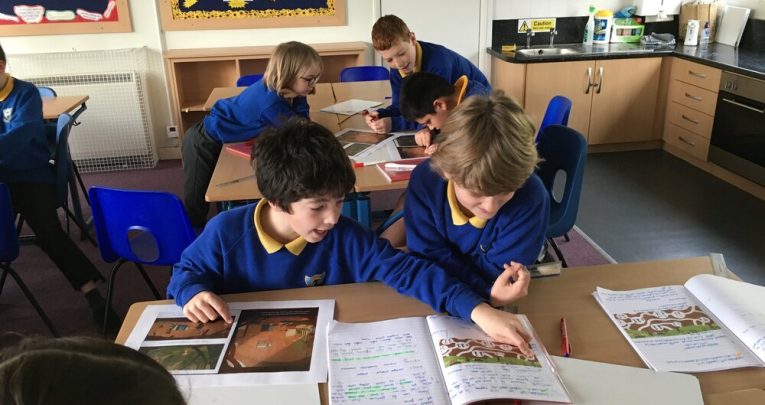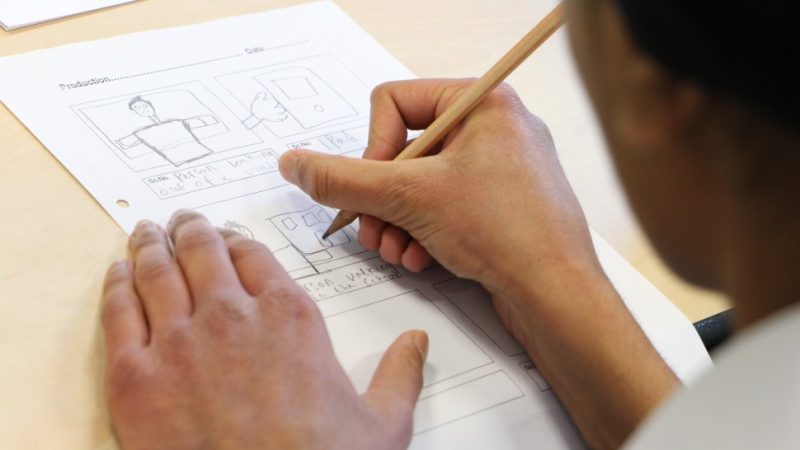Visual literacy – Use pictures to help pupils understand and communicate meaning

In classrooms where the written word is prioritised, how do we recognise the power of pictures?

As a writer who also draws, I’m interested in how we connect with another person through words and pictures. How we engage, how we animate, how we get an idea to live in another mind.
When I read to children, I’m endlessly amazed by the power of a picture book. That a character is grippingly alive for those kids. An inky drawing of an enormous, lonely gorilla playing a piano, transforms into a living breathing being, deserving of love. It blows my mind. Every time.
There is something very special about that space in between pictures and words. A place which asks your imagination to fill the gap. Pictures don’t simply illustrate the words – they tell their own story, on a multitude of levels. If we make time to examine them.
Early learning
From the moment a child comes into the world they are searching for visual clues. We understand complex expressions and emotions through drawings from a very early age, in ways we can’t yet do with the written word or spoken language.
Trying to understand if you are friend or foe, through facial expression and body language. Pictures speak this language fluently.
They intimate emotions, feelings and nuances that words cannot because of this sophisticated visual vocabulary (which we are constantly building).
Pictures are open to interpretation – there’s nothing concrete to get right or wrong – which means they’re open to discussion.
By the time a child arrives at primary school they’re able to use this visual vocabulary creatively when they ‘read’ pictures and when they draw, yet we don’t harness either.
Worse still, most children have given up drawing by the age of nine or 10 (believing there’s a right and wrong way – there isn’t). In doing so, they lose a vital form of self-expression which they don’t have another outlet for.
This is careless of us, especially in these times where we’re supposedly more aware than ever of emotional wellbeing.
Visual literacy
I struggled enormously with literacy projects at school; English comprehension was an unending nightmare. I just didn’t get it.
Drawing was another matter. Some children are academic thinkers – others, just as bright, think in other ways; spatially or visually. We must learn how to engage them, so they don’t come to believe, as I did, that they aren’t worth much.
As an author, I’m struck by how we ask children to complete literacy tasks… how sterile it can be and how far away it is from how I and many other authors actually find our ideas as we write.
Rather than writing, many of us draw to generate our ideas; to map out the world of our books, to develop our characters.
The Power of Pictures programme shows how to place drawing into the writing process. We (author/illustrators) show teachers exactly how we draw to create a terrain in which we can then write.
There is a beautiful video you may have seen on the internet; Oliver Sacks’ music and memory project ‘Alive Inside’, which works with Alzheimer’s sufferers.
The video shows Henry, in a nursing home for ten years and completely inert. Unresponsive and closed in on himself. Henry is then given an iPod containing his favourite music.
Immediately he lights up, his face assumes expression, his eyes open wide, he starts to sing – he’s being animated by the music. The effect doesn’t stop when the headphones come off.
Henry, normally mute, is quite voluble – he is animated, he has come to life. ‘Kant called music the quickening art – and Henry is being quickened… being brought to life,’ says Sacks.
In a very similar way, pictures and drawing can reach across divides. They engage.
Ideas in practice
When we read visual texts, the words only tell one part of the story. Additional details about characters, settings, relationships and story events are often more richly conveyed in what the illustrator chooses to place in the image.
Allow time for children to closely read illustrations, encouraging them to look at elements such as characters’ facial expressions, body positions, props, background settings (or lack of them), choices of colour, scale and perspective, and the way our eye is led across the page.
All these things contribute to a deeper understanding of what’s been read. Picturebooks are designed for readers to stop and pore over, and go back and re-read as meanings unfold.
Multiple readings of a picturebook are a good thing – at least three times is needed to begin to unlock the full meaning.
Time for discussion
Picture books are often a lot more sophisticated than you’d expect, too. Texts such as How to Be a Lion have allowed children to have rich and nuanced discussions around complex themes such as nature and nurture, difference, masculinity and self-acceptance.
With older children, their extended life experiences mean that they can make connections based on personal experiences that they would not have done when they were younger.
Ideas and meaning
In their earliest years, children use drawing freely to communicate ideas, but as they get older it is still important to allow pupils to think and represent their ideas this way.
It helps them to formulate, develop and extend their thinking, and create authentic characters, settings or plot ideas. Author/illustrator draw-along videos, such as those on CLPE’s website, show children how to create and shape characters through illustration, and will give them ideas to build characters of their own.
Ed Vere is an award-winning author and illustrator. Alongside Charlotte Hacking, learning programmes leader at the Centre for Literacy in Primary Education (CLPE), he devised the Power of Pictures programme, which focuses on developing children’s visual literacy skills through reading picturebooks and incorporating illustration into the writing process.











